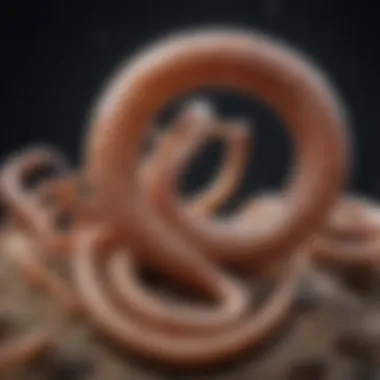Comprehensive Strategies for Pinworm Treatment


Overview of Research Topic
Brief Background and Context
Pinworm infections, caused by the parasite Enterobius vermicularis, are among the most common helminth infections worldwide, especially in children. These small, white worms thrive in the human intestine, where they lay eggs. This can lead to itching, sleep disturbances, and irritability. Understanding pinworm infections is not just about addressing the discomfort they cause; it involves a broader perspective on infection control and public health.
Importance in Current Scientific Landscape
The need to address pinworm infections is crucial in today’s health landscape. While they may seem trivial compared to other infections, the impact on quality of life can be significant. Moreover, their ability to spread quickly in communal living environments emphasizes the importance of preventive measures. Current research is shifting towards effective communication of hygiene practices and the development of more efficient treatment protocols.
Methodology
Research Design and Approach
This article employs a comprehensive literature review methodology, evaluating peer-reviewed studies, health organization guidelines, and expert opinions. By analyzing this data, we provide a contextual framework to understand effective interventions for pinworm management and prevention.
Data Collection Techniques
Data is collected through multiple means:
- Research articles from databases such as PubMed and Google Scholar.
- Health organization resources including the Centers for Disease Control and Prevention (CDC) and the World Health Organization (WHO).
- Input from discussions on forums such as Reddit and information exchange platforms.
The integration of various data sources allows for a more thorough understanding of this public health concern, guiding evidence-based practices for treatment and prevention.
Understanding Pinworm Infections
Understanding pinworm infections is crucial for multiple reasons, especially considering their prevalence among various populations. This segment lays the foundation for the entire article by defining these infections, exploring their life cycle, and detailing how they spread. Awareness and knowledge about pinworms empower individuals and health practitioners to recognize the symptoms early and implement effective treatment strategies.
Definition of Pinworms
Pinworms are small, thin, white parasitic worms scientifically known as Enterobius vermicularis. They are the most common type of intestinal worm infection in the United States, particularly affecting children between the ages of 5 and 14 years. An adult female pinworm measures around 8 to 13 millimeters in length and can live for several weeks in the human intestine. After mating, females migrate to the anus, where they lay eggs, causing discomfort and itching. Understanding the definition of pinworms is the first step to recognizing the infection and its impact on health.
Life Cycle of Pinworms
The life cycle of pinworms is reasonably straightforward but highlights the adaptability of these parasites. Once a person ingests pinworm eggs, either through contaminated hands or surfaces, larvae hatch in the intestine. They grow into adults within four to six weeks. Mating occurs within the intestine, and female pinworms venture out at night to lay eggs around the anal area. This process can cause intense itching, prompting scratching, which may lead to further egg dissemination. These eggs can survive on surfaces for several weeks, emphasizing the necessity of stringent hygiene practices. The entire cycle can repeat itself if hygiene is not maintained.
Transmission Methods
Pinworms primarily spread through the fecal-oral route. The key transmission methods include:
- Direct contact: Scratching around the anus transfers eggs to the fingers.
- Indirect contact: Contaminated surfaces, clothing, or bedding can harbor pinworm eggs.
- Ingestion: Eggs are sometimes ingested unknowingly, especially by children who have not yet developed adequate hygiene habits.
The ease of transmission highlights the importance of education on personal and household hygiene. Public awareness campaigns can effectively mitigate the spread and help manage pinworm infections in communities. The role of personal hygiene is paramount in preventing the re-infection cycle, underscoring the significance of understanding how pinworms are transmitted.
Symptoms of Pinworm Infections
Understanding the symptoms of pinworm infections is crucial for both timely diagnosis and effective treatment. Pinworms, particularly common among children, can lead to discomfort and disruptions in daily activities. Recognizing the signs allows for prompt action, minimizing the potential for complications. Awareness of these symptoms can ultimately foster better hygiene practices, helping to curb the spread of these parasites.
Common Symptoms
The primary symptoms of pinworm infections usually stem from the female pinworms laying eggs in the anal area, primarily at night. Some of the common symptoms include:
- Itching and discomfort: One of the most notable symptoms is intense itching around the anus, which can interfere with sleep and daily activities.
- Restlessness during sleep: The itching may cause restlessness, leading to disrupted sleep patterns.
- Irritability or behavioral changes: In young children, this discomfort can manifest as irritability or unusual behavior.
- Visible worms: In some cases, adult pinworms can be seen in the stool or around the anal area, particularly after scratching.
- Secondary infections: Scratching the infected area may lead to additional skin infections due to bacteria entering through the broken skin.
Identifying these symptoms is the first step towards effective treatment. Early intervention can prevent worsening discomfort and assist in curtailing the spread.


Complications from Severe Infections
Though pinworm infections are often not serious, complications can arise if left untreated. These complications may include:
- Bacterial infections: Continuous scratching may lead to bacterial infections of the skin. These infections can necessitate further medical treatment.
- Intestinal inflammation: In rare instances, an accumulation of pinworms can lead to intestinal inflammation or blockage, though this is uncommon in healthy individuals.
- Sleep disturbances: Severe itching can lead to chronic sleep disturbances, affecting overall health and well-being.
- Emotional and psychological effects: Chronic infections can lead to anxiety or stress in affected individuals, including fear of social or educational settings.
Recognizing the symptoms of pinworm infections early can prevent more serious complications and promote healthier living environments, particularly for children.
By understanding these symptoms and the potential complications associated with pinworm infections, individuals are better equipped to seek timely medical advice, leading to more effective and prompt treatment.
Diagnosis of Pinworm Infections
Diagnosis plays a crucial role in the effective management of pinworm infections. Accurate identification of pinworms is essential for several reasons. First and foremost, it not only helps in initiating timely treatment but also in alleviating symptoms experienced by infected individuals. Additionally, proper diagnosis reduces the risk of further transmission in communities, especially in households with children, where pinworms are particularly common.
Understanding the specific methods for diagnosis is vital. It enables healthcare professionals to choose the most suitable diagnostic tool, leading to more reliable results. Therefore, this section will explore different methods available for diagnosing pinworm infections, focusing on their effectiveness and practicality.
Methods for Diagnosis
There are various methods available for diagnosing pinworm infections. The most commonly used method is the tape test. In this process, a piece of transparent tape is applied to the skin around the anus during the night or early morning. As pinworms usually come out at night to lay eggs, this test can capture them for examination under a microscope.
Another method involves visual inspection. In this scenario, a healthcare provider examines the anal region for the presence of adult pinworms or eggs. Although less sensitive, it serves as a quick screening tool. Stool tests are also performed, though they are generally not very effective for pinworms, as the worms do not typically pass in feces.
In recent years, some laboratories have introduced more specific molecular techniques, like PCR (polymerase chain reaction), which can detect pinworm DNA in samples. These methods offer high specificity and sensitivity but may not yet be widely available, particularly in primary care settings.
Importance of Accurate Diagnosis
Accurate diagnosis of pinworm infections is paramount for several reasons. Firstly, it ensures that treatment is appropriately targeted. Misdiagnosis can lead to inappropriate use of medications, which may not only be ineffective but could also cause adverse reactions. Therefore, confirming the presence of pinworms before administering treatment is essential.
Additionally, accurate diagnosis helps in public health initiatives. For instance, when pinworm infections are diagnosed accurately, it can lead to better monitoring of the infection's prevalence in populations. This information aids healthcare officials in developing effective measures to educate communities, targeting prevention efforts more efficiently.
Furthermore, awareness of pinworm infections can mitigate the psychological burden experienced by patients and their families. Knowing that the diagnosis is precise helps reduce stigma and fosters a more straightforward approach to treatment and education within affected communities.
"Timely and accurate diagnosis of pinworm infections can significantly improve outcomes and minimize transmission risks."
In summary, the diagnosis of pinworm infections is not merely a formal step; it is a critical component that influences treatment effectiveness, public health management, and the overall well-being of individuals affected by these parasites.
Pharmacological Treatments
Pharmacological treatments form the cornerstone of therapy for pinworm infections. They provide a straightforward and effective method for eliminating the parasites from the host's intestines. Quick and direct action of medications significantly reduces the duration of the infection and alleviates associated discomfort. Understanding these treatments and their appropriate use is essential for both healthcare providers and patients aiming to achieve a successful resolution of pinworm infestations.
Over-the-Counter Medications
Several over-the-counter medications are available to treat pinworm infections. The most notable among them is Pyrantel Pamoate. This medication is known for its ability to paralyze the pinworms, allowing them to be expelled from the intestine during a bowel movement.
The advantages of over-the-counter treatments include easy accessibility and a simplified treatment regimen. However, it is important for individuals to follow dosage instructions carefully. Not adhering to these guidelines may result in a failure to eliminate the infection completely, leading to potential reinfestation.
In addition to Pyrantel Pamoate, Mebendazole is another common over-the-counter option. This medication works by inhibiting the worms’ ability to absorb glucose, ultimately causing their death. Mebendazole may be preferred due to its single-dose effectiveness and minimal side effects.
Prescription Medication Options
While over-the-counter options are helpful, some circumstances may require prescription medications. Albendazole is a widely prescribed treatment for pinworm infections. This medication is effective in eliminating a wide range of intestinal parasites, including pinworms. Albendazole works similarly to Mebendazole but may be used when a more aggressive treatment is needed or when symptoms persist after initial treatment.
Healthcare providers might also recommend combinations of treatments for stubborn infestations. Tailoring treatment plans based on individual symptoms and patient history often leads to better outcomes.
Mechanism of Action of Common Treatments


Understanding the mechanism of action of common pinworm treatments helps clarify how these medications achieve their effects.
- Pyrantel Pamoate works through an agonistic action on nicotinic receptors present in the parasite, causing paralysis. This paralysis prevents the pinworms from holding onto the intestinal lining, facilitating their expulsion.
- Mebendazole disrupts the tubulin polymerization in pinworms, which is crucial for maintaining their cell structure and function. Without this ability, the worms cannot sustain themselves, leading to their demise.
- Albendazole operates similarly to Mebendazole but with a broader range of action on various parasitic strains.
Implications of these mechanisms underline the importance of proper administration. Hence, it is vital to understand the specific medication being used and its expected impact.
"A comprehensive understanding of pharmacological treatments equates to better application and patient outcomes in managing pinworm infections."
Following these treatment options, it remains important for individuals to seek medical advice, particularly if symptoms recur or persist. Effective management not only involves medication but also consistent follow-up and vigilance regarding hygiene and prevention practices.
Home Remedies for Pinworm Treatment
Home remedies for pinworm treatment hold significant relevance in addressing this common infection, especially for those who prefer non-pharmaceutical approaches. Exploring alternatives can provide valuable insights for individuals seeking to understand the impact of dietary changes and natural remedies in combating pinworm infestations. Although not a replacement for medical treatments, these remedies serve as complementary options that may aid in reducing symptoms and preventing recurrence. Through effective home strategies, individuals can promote better hygiene and health within their households.
Dietary Considerations
Dietary choices play a crucial role in managing pinworm infections. Certain foods can inadvertently exacerbate symptoms or contribute to overall health. It is essential to focus on incorporating nutrients that bolster the immune system, which can enhance the body's ability to combat infections. In particular, dietary fibers found in fruits and vegetables facilitate digestion and contribute to a healthier intestinal environment suitable for fighting pinworms.
Including garlic, known for its antimicrobial properties, may provide an additional advantage as it could help in reducing pinworm populations. Furthermore, foods such as pumpkin seeds, which contain compounds that are believed to be effective against parasitic infections, should be considered. Consuming probiotics from fermented foods like yogurt can also support gut health, fostering a balanced microbiome that can resist infections more effectively.
Herbal Remedies
Herbal remedies have been historically utilized for a range of health issues, and pinworm treatment is no exception. Some herbs are believed to possess antiparasitic qualities that may aid in the fight against pinworms. For instance, wormwood and black walnut are commonly recommended in natural health circles for their potential effectiveness against parasites. These herbs can be consumed as teas or supplements, ideally under the guidance of a healthcare professional.
Another notable herb is thyme, which not only adds flavor to meals but may also offer some antiparasitic benefits. The potential therapeutic properties of these herbs underscore the significance of incorporating traditional knowledge in modern health practices. However, it is crucial to approach herbal remedies cautiously and be aware of possible side effects and contraindications when combined with other treatments.
Effectiveness of Home Treatments
Assessing the effectiveness of home treatments for pinworm infections requires a critical evaluation of anecdotal and scientific evidence. Many individuals report varying degrees of success with dietary modifications and herbal remedies. However, scientific literature remains limited on the efficacy of such treatments specifically targeting pinworms. While some individuals may experience relief from symptoms through these methods, results can differ widely based on individual circumstances and the severity of the infection.
Incorporating home remedies should be part of a comprehensive strategy that includes proper hygiene practices and, when necessary, the use of medical treatments. Well-implemented diet changes and targeted herbal applications might complement pharmaceutical options effectively. Ultimately, ongoing research is necessary to validate and elucidate the role of home remedies in treating pinworm infections thoroughly.
It is imperative to acknowledge the limitations of home treatments, especially in severe cases, and seek professional medical advice for effective management.
Hygiene Practices to Prevent Recurrence
Hygiene practices play a critical role in preventing the recurrence of pinworm infections. Addressing hygiene systematically not only helps in treatment but also thwarts future outbreaks. Understanding the specific aspects of hygiene can empower individuals and communities to combat this common yet often overlooked infection.
Maintaining rigorous hygiene can disrupt the life cycle of pinworms. Given that pinworm eggs can survive on surfaces for weeks, meticulous personal and environmental hygiene is essential. Regular cleaning and personal care are effective strategies that can greatly minimize the risk of reinfection. Formulating a practical hygiene protocol is thus a cornerstone in not only treating existing infections but also in ensuring they do not recur.
Personal Hygiene Recommendations
Individual hygiene is paramount in preventing pinworm recurrence. Efforts should focus on habits that disrupt the spread and survival of pinworm eggs. Key recommendations include:
- Regular Handwashing: Wash hands thoroughly with soap and water, especially after using the toilet and before preparing food. This practice eliminates any eggs that may have been unintentionally transferred.
- Nail Care: Keep fingernails short and clean. This helps to prevent eggs from accumulating under the nails, reducing the risk of transferring them to the mouth or other surfaces.
- Nightly Baths: Taking a bath each night can wash away eggs that may have accumulated during the day. This practice is particularly important for children, as they often touch various surfaces and play close to the ground.
- Laundry Practices: Change and wash bed linens, nightclothes, and underwear regularly in hot water. This practice ensures that any eggs are killed and do not infect others.
"Proper personal hygiene not only treats pinworm infections but also serves as a bulwark against reinfections."
Household Hygiene Protocols
Household hygiene is equally essential in tackling pinworm infections. A clean home environment can significantly reduce the likelihood of eggs surviving and spreading. Recommended household hygiene protocols include:
- Regular Cleaning: Frequently clean floors, surfaces, and bathrooms with disinfectants. Special attention should be paid to areas where children play.
- Vacuuming: Regular vacuuming can help remove stray eggs from carpets and upholstery. It's important to empty the vacuum cleaner outside to prevent any potential recontamination.
- Separation of Personal Items: Avoid sharing personal items such as towels, bedding, and clothing, particularly among family members. This prevents the spreading of eggs from one individual to another.
- Kitchen Hygiene: In the kitchen, ensure that cutting boards and utensils are washed thoroughly and kept separate from raw food items. Proper food hygiene can also mitigate other health risks.
These hygiene practices, when fully integrated into daily life, help prevent the recurrence of pinworm infections. By taking both personal and household hygiene seriously, individuals can contribute to a healthier environment, breaking the cycle of infection.


Community Health Approaches
Community health approaches are crucial in addressing pinworm infections due to their potential to affect entire populations. Understanding how pinworms spread and the social contexts in which infections occur can lead to effective prevention and control measures. In many communities, especially those with limited access to healthcare, the burden of pinworm infections can be significant. Community-wide strategies not only enhance public health but also promote a sense of shared responsibility.
Education and Awareness Initiatives
Education and awareness initiatives play a pivotal role in combating pinworm infections. These programs inform the community about the life cycle of pinworms, how infections occur, and the symptoms to watch for. Increased knowledge empowers individuals to take protective measures, reducing the incidence of transmission.
Workshops in schools, community centers, and clinics can educate families about hygiene practices. Emphasizing the importance of washing hands after using the bathroom and before meals is essential. Proper disposal of waste can also deter pinworm spread, as this parasite thrives in environments where hygiene is lacking.
Effective communication about symptoms can lead to early diagnosis and treatment, thus minimizing outbreaks. Campaigns can utilize platforms like social media or local broadcast channels to reach a broader audience and ensure that accurate information reaches as many community members as possible.
"Preventive education is as important as medical treatment in controlling pinworm infections."
Role of Public Health Officials
Public health officials are central to the success of community health approaches for managing pinworm infections. They serve as strategic leaders in the dissemination of knowledge, coordination of resources, and implementation of health programs. Their roles include conducting epidemiological studies to assess the prevalence of pinworm infections and identifying high-risk populations.
Additionally, public health officials can collaborate with educational institutions and community organizations to organize health fairs or awareness campaigns. These events can also encourage community engagement, fostering teamwork around health issues that affect everyone.
Finally, public health officials must also advocate for improved access to healthcare services, particularly in under-resourced areas. By ensuring that effective treatment options and health information are available, these officials help to reduce the incidence and impact of pinworm infections in communities.
In summary, community health approaches emphasize the blend of education, awareness, and public health initiatives. They not only mitigate the prevalence of pinworms but also contribute to the overall health and well-being of entire populations.
Impact of Pinworm Infections on Populations
Understanding the impact of pinworm infections on a larger scale is crucial for addressing the public health challenge they pose. These tiny parasites can lead to significant health issues, particularly in children, affecting their physical well-being and psychological health. The implications extend beyond individual cases, influencing family units, educational settings, and broader community health.
Epidemiology of Pinworm Infections
Pinworm infections, primarily caused by Enterobius vermicularis, are common, especially in children. These infections are prevalent in various geographical regions, although they tend to be more frequent in areas with poor hygiene practices. The Centers for Disease Control and Prevention estimate that nearly 40 million people are affected at any time in the United States, with the majority being school-aged children. The transmission occurs easily in crowded environments, such as schools and daycare centers.
The life cycle of pinworms supports their rapid spread. Adult female pinworms lay eggs in the perianal area, typically at night. This behavior often results in scratching, leading to the contamination of hands, bedding, clothing, and household surfaces. Thus, pinworms can spread quickly among family members and contacts, necessitating comprehensive public health strategies to manage outbreaks.
Societal Implications
The societal implications of pinworm infections are profound. The presence of pinworms can affect educational performance. Children suffering from irritation or sleep disturbances due to itching may find it difficult to concentrate in class. This leads to decreases in academic performance and overall development.
Healthcare systems also bear a burden as they must manage the infections and associated complications. While pinworm infections are not typically life-threatening, severe cases may result in secondary infections or other complications requiring medical intervention.
"Pinworms are not just a nuisance; they impact whole communities, influencing school attendance, healthcare costs, and family dynamics."
Preventing the spread of pinworms involves a multi-faceted approach, including education, improving hygiene practices, and fostering awareness about the infection. Public health initiatives that teach communities about transmission, proper sanitation, and treatment options can lead to dramatic decreases in infection rates.
Overall, the impact of pinworms extends beyond immediate health issues. Recognizing their broader effects on populations is essential for developing effective strategies for mitigation and treatment.
Addressing the epidemic of pinworm infections requires joint efforts from families, schools, and public health officials to create a healthier community for all.
Epilogue and Future Directions
The study of pinworm infections is crucial due to their direct impact on public health, particularly among children. Understanding effective treatment methods and preventative strategies will help mitigate these infections’ prevalence. The complexity of pinworm life cycles and transmission emphasizes the need for a comprehensive approach that combines medical, hygienic, and community-focused efforts.
Summary of Effective Treatments
Pinworm infections can be treated with a range of approaches. Effective treatments typically include both pharmacological options and non-pharmaceutical methods. Over-the-counter medications, such as Pyrantel pamoate and mebendazole, have been shown to eliminate pinworms effectively. These medications are non-prescription, which makes them accessible to most individuals. Additionally, prescription medications may be necessary for severe cases or persistent infections.
Home remedies can also provide some relief. Many people find dietary changes helpful, like increasing fiber intake, which might help reduce symptoms. Herbal treatments such as garlic and wormwood have also been traditionally used, although scientific support for their efficacy is limited.
Importance of Continued Research
Research on pinworm infections must continue to ensure effective treatment and prevention strategies. Pinworms are often under-researched in both clinical and public health contexts. Continued investigations into the effectiveness of current treatments are essential.
Moreover, exploring new treatment avenues could lead to more effective therapies. For instance, understanding the interactions between treatments and various demographics, such as children or immunocompromised individuals, is vital to tailor approaches. Also, further studies on the socio-economic factors contributing to pinworm infections can inform educational and public health initiatives.



